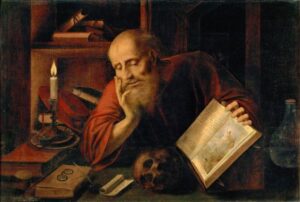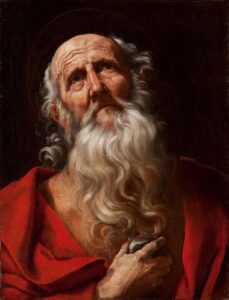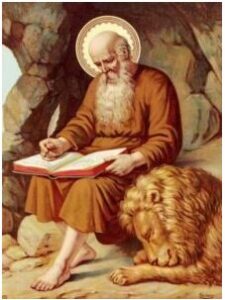St. Jerome – Sep 30 I Theologian, Historian and Great Christian Scholar of all time

St. Jerome traditionally regarded as the most learned of the Latin Fathers. He was a hermit, a Latin priest, a teacher, confessor, monastic leader, theologian, and historian. He was an avid student, a thorough scholar, a prodigious letter-writer. One of the greatest Christian scholars of all time, he is recognized as a Saint and Doctor of the Church by the Roman Catholic Church, the Eastern Orthodox Church, the Lutheran Church, and the Anglican Church. A venerable and God-bearing father Jerome was noted as a scholar of Latin at the time when Greek was considered the language of scholarship. He was a biblical translator and monastic leader, traditionally regarded as the most learned of the Latin Fathers.
Jerome was born as Eusebius Sophronius Hieronymus around the year 340, of well-to-do Christian parents in Stridonius on the border between Pannonia and Dalmatia, in what is now Bosnia/Herzegovina. He was born into a Christian family; but was not baptized until AD 360 when he journeyed to Rome. His father Eusebius was a wealthy landowner. Under his father’s direction he was well instructed at home, till the age 12. He was then sent to pursue his studies in Milan and Rome where he studied Greek, Latin classics, grammar, rhetoric, and philosophy as well as learning Koine Greek.

After these preparatory studies, he travelled extensively in Palestine, marking each spot of Christ’s life with an outpouring of devotion. He spent five years in the desert, so that he might give himself up to prayer, penance, and study. Finally, he settled in Bethlehem, where he lived in the cave believed to have been the birthplace of Christ.
A serious scholar enamoured of Latin literature, he frequented the catacombs and near the end of his Roman education was baptized, in Rome. He became interested in ecclesiastical matters. He stayed for a period in Antioch where, through visions when he was seriously ill, he resolved to lay aside his secular studies and plunged into study of the Bible. Looking to a life of asceticism he went into the desert of Chalcis. In this environment he began a study of Hebrew and found time for writing.

He was one of the most learned of the Fathers of the Western Church and is noted as the translator of the holy scriptures into Latin. This translation, the Vulgate, though not a critical edition of the Bible, as a modern scholar says, “No man before Jerome or among his contemporaries and very few men for many centuries afterwards were so well qualified to do the work.” declared it the authentic text to be used in the Church. In his adult life he traveled extensively, learning Greek and Hebrew, while pursuing his rhetorical and philosophical studies. Among the many treatises, commentaries, translations, and exegetical works that he undertook was the revision of the Latin bible using the more recent versions of the Hebrew Old Testament. To be able to do such work, Jerome prepared himself well. His mastery over Latin, Greek, Hebrew, and Chaldaic helped him.
An ascetic and harsh critic of secular excesses, he was a strong defender of the Orthodox faith against the heresies of his time. About AD 378, on returning to Antioch he was ordained a priest. Then shortly afterwards he traveled to Constantinople and continued his studies of the Scripture under the guidance of St. Gregory the Theologian. At this time, he undertook the updating of the Latin Bible on the basic of the Greek New Testament and the Septuagint to end the differences that had entered the western texts. Jerome spent almost three years (379–382) continuing his pursuit of scriptural studies. An enthusiastic disciple of St. Gregory of Nazianzus, Jerome also came to know St. Gregory of Nyssa at the Council of Constantinople (AD 381). Under such influences he improved his knowledge of Greek and developed an admiration for Origen’s exegesis. He translated 14 of homilies (sermons) of Origen on Old Testament books into Latin.
Having maintained a monastic lifestyle, his criticisms of the secular clergy led to increased hostility from the clergy and their supporters. He returned to Antioch in AD 385. There he found life in the secular world burdensome. He moved to Palestine to settle down to a life in a hermit’s cell. In this settled environment he began his most important works. During the last 34 years of his life, he produced his best commentaries. He lived for a time as a hermit, became a priest, and about, 389, established a monastery at Bethlehem. His numerous biblical, ascetical, monastic, and theological works profoundly influenced the early Middle Ages.
Saints are remembered for some outstanding virtues and devotion, but Jerome is frequently remembered for his bad temper! Even though he had a very bad temper, his love for God and his son Jesus Christ was extraordinarily intense. He was sarcastic against anyone who taught error was an enemy of God and truth and he used vitriolic pen against them. Saint Augustine said of him, “What Jerome is ignorant of, no mortal has ever known.” Jerome was a strong, outspoken man. He had the virtues and the unpleasant fruits of being a fearless critic and all the usual moral problems of a man. He was swift to anger, but also swift to feel remorse, even more severe on his own shortcomings than on those of others.

A story from the life of Saint Jerome, narrates that one day, a lion entered the monastery where Jerome resided. His fellow monks ran away, but Jerome recognized that the beast was injured, and he cured it by removing a thorn from its paw. The encounter between man and animal, in which Jerome comes to the lion’s aid, is poignant, showing the moment when the lion submits to the saint, the saint’s concentration as he removes the thorn, and the apprehensiveness of the attendant monk.
An ascetic and harsh critic of secular excesses, he was a strong defender of the Orthodox faith against the heresies of his time. He was above all a Scripture scholar, translating most of the Old Testament from the Hebrew. Jerome also wrote commentaries which are a great source of scriptural inspiration for us today. He passed away on September 30, 420, near Bethlehem where he was originally buried, and the remains of his body now lie buried in the Basilica of St. Mary Major in Rome. His feast day is 30 September and June 15.
Few Quotes of St Jerome
“Ignorance of Scripture is ignorance of Christ.” ~ St Jerome
“When the stomach is full, it is easy to talk of fasting” ~ St Jerome
“A clergyman who engages in business, and who rises from poverty to wealth, and from obscurity to a high position, avoid as you would the plague.” ~ St Jerome
“Be at peace with your own soul, then heaven and earth will be at peace with you.” ~ St Jerome
“A friend is long sought, hardly found, and with difficulty kept.” ~ St Jerome
“Thank God I am deemed worthy to be hated by the world.” ~ St Jerome
“True friendship ought never to conceal what it thinks.” ~ St Jerome
“Keep doing some kind of work, that the devil may always find you employed.” ~ St Jerome
“It is worse still to be ignorant of your ignorance.” ~ St Jerome
“We must love Christ and always seek Christ’s embraces. Then everything difficult will seem easy.” ~ St Jerome
“Read assiduously and learn as much as you can. Let sleep find you holding the Bible, and when your head nods, let it be resting on the sacred page” ~ St Jerome
“When we pray we speak to God; but when we read, God speaks to us.” ~ St. Jerome
“It is our part to seek, His to grant what we ask; ours to make a beginning, His to bring it to completion; ours to offer what we can, His to finish what we cannot.” ~ St. Jerome
“Martyrdom does not consist only in dying for one’s faith. Martyrdom also consists in serving God with love and purity of heart every day of one’s life” ~ St. Jerome
“Be ever engaged, so that whenever the devil calls, he may find you occupied.” ~ St. Jerome
“We must love Christ and always seek Christ’s embraces. Then everything difficult will seem easy.” ~ St. Jerome
0 Comments